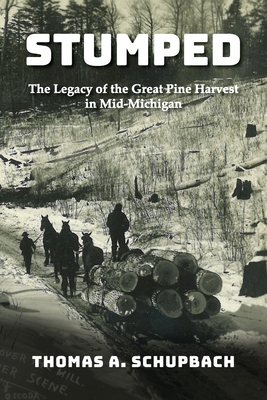Stumped: Harvesting the Great Pine Forest in Mid-Michigan and the Cutover Legacy

Stumped: Harvesting the Great Pine Forest in Mid-Michigan and the Cutover Legacy
When Michigan joined the Union, in 1837, it acquired nearly 14 million acres of land from the 1836 treaty. It took several years to survey the land, at which point the complex process of land "disposal" began, ultimately resulting in private ownership. This occurred just in time for the lumber industry to move its focus from exhausted lands in New England to the great pine forests of Michigan.
By the time the great pine lumbering industry arrived in mid-Michigan, in the 1880s and '90s, the industry had reached its apogee in cutting massive swaths of forests in the northern Lower Peninsula of Michigan. The lumber companies then turned their focus on three counties: Roscommon, Gladwin, and Clare, which included West Nester Township, and two major logging rivers, the Muskegon and the Saginaw. Here, standard-gauge rail lines were needed to extend the range of the river systems to deliver these remote harvests.
After the harvest, land speculation of the cut-over sections was the order of the day. Attempts to extract additional value from these lands included agriculture and turpentine production. Using the exemplar of West Nester Township, the author proves the folly of these efforts and reveals the true value of this land.
This historical description of that development is rich and fascinating.
PRP: 105.48 Lei
Acesta este Prețul Recomandat de Producător. Prețul de vânzare al produsului este afișat mai jos.
94.93Lei
94.93Lei
105.48 LeiLivrare in 2-4 saptamani
Descrierea produsului
When Michigan joined the Union, in 1837, it acquired nearly 14 million acres of land from the 1836 treaty. It took several years to survey the land, at which point the complex process of land "disposal" began, ultimately resulting in private ownership. This occurred just in time for the lumber industry to move its focus from exhausted lands in New England to the great pine forests of Michigan.
By the time the great pine lumbering industry arrived in mid-Michigan, in the 1880s and '90s, the industry had reached its apogee in cutting massive swaths of forests in the northern Lower Peninsula of Michigan. The lumber companies then turned their focus on three counties: Roscommon, Gladwin, and Clare, which included West Nester Township, and two major logging rivers, the Muskegon and the Saginaw. Here, standard-gauge rail lines were needed to extend the range of the river systems to deliver these remote harvests.
After the harvest, land speculation of the cut-over sections was the order of the day. Attempts to extract additional value from these lands included agriculture and turpentine production. Using the exemplar of West Nester Township, the author proves the folly of these efforts and reveals the true value of this land.
This historical description of that development is rich and fascinating.
Detaliile produsului










